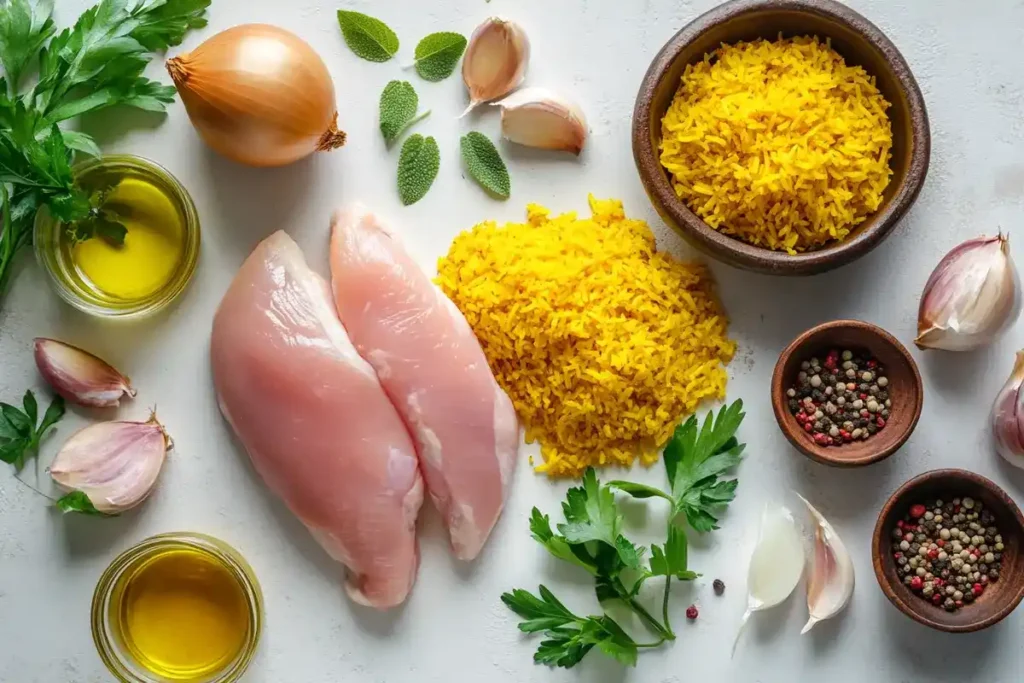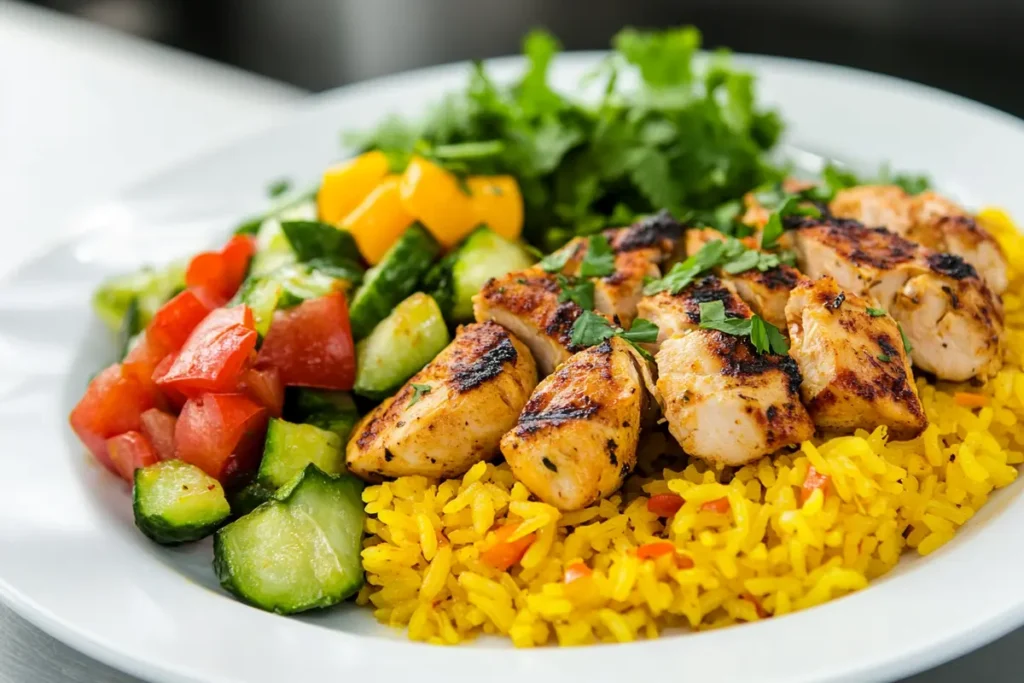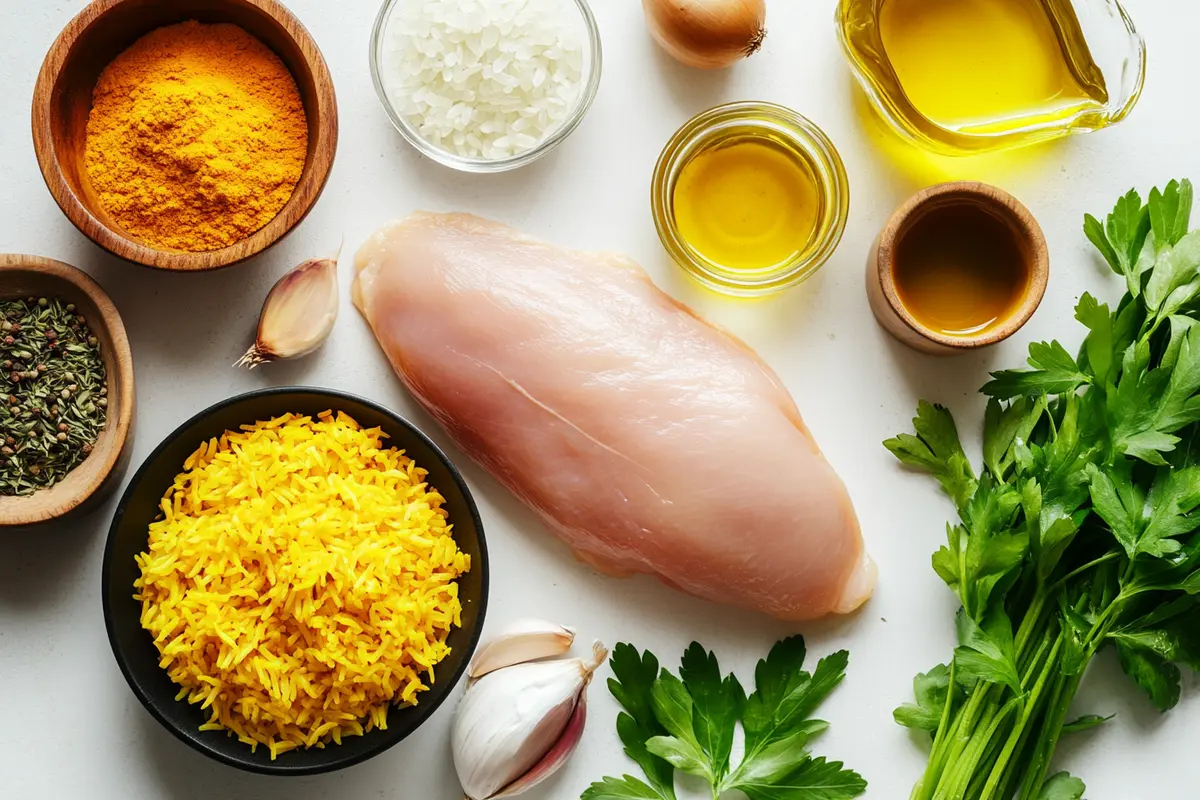When it comes to meal planning, yellow rice and chicken often grace tables as a flavorful, hearty dish that promises satisfaction. But is it as healthy as it is delicious? This article dives into the nutritional aspects, benefits, potential concerns, and tips for preparing a healthier version of this popular dish. By the end, you’ll understand whether yellow rice and chicken fits into a balanced diet and how to make it even better for your health.
Is Yellow Rice and Chicken Healthy?
Overview of Yellow Rice and Chicken
Yellow rice and chicken are a classic pairing in various cuisines worldwide. The rich golden hue of yellow rice often comes from spices like turmeric or saffron, both of which offer their own health benefits. Chicken, on the other hand, is a versatile and lean protein source, widely appreciated for its role in building muscle and maintaining energy levels.
This dish is not only a delight for the palate but also a cultural staple in regions such as Latin America, the Caribbean, and parts of Asia. Yet, its nutritional value largely depends on how it’s prepared, the portion sizes, and the additional ingredients.
Importance of Evaluating Meal Healthiness
Why should we evaluate whether yellow rice and chicken are healthy? Well, many seemingly harmless meals can carry hidden calories, excess sodium, or unhealthy fats. While yellow rice and chicken offer wholesome components, the preparation style can make or break its role in a balanced diet.
For instance, rice can be high in carbohydrates, which may not align with certain health goals. Additionally, pre-made or boxed versions of yellow rice often contain added preservatives, artificial coloring, or unnecessary sodium. As for chicken, breaded or deep-fried options can significantly alter the nutritional profile.
By carefully examining the preparation methods and understanding the core ingredients, you can make informed choices and turn yellow rice and chicken into a dish that supports your health rather than detracts from it.
Nutritional Breakdown
Nutritional Composition of Yellow Rice
Yellow rice derives its vibrant color from spices like turmeric or saffron, both of which offer more than just visual appeal. However, its nutritional content depends on whether it’s made from white or whole-grain rice and the additional ingredients used.
Ingredients and Preparation Methods
Traditional yellow rice recipes often call for ingredients such as rice, broth, onions, garlic, and turmeric or saffron. While this sounds wholesome, store-bought yellow rice mixes may include artificial dyes, excessive sodium, and preservatives. Opting for homemade versions allows for control over the ingredients, making it easier to prepare a nutrient-dense dish.
Macronutrient Profile
- Carbohydrates: Yellow rice is a high-carb food, with white rice providing quick energy due to its high glycemic index. Switching to whole-grain options like brown rice can improve the fiber content and reduce spikes in blood sugar levels.
- Fats: Yellow rice is typically low in fats unless prepared with butter or oil. Choosing healthy fats like olive oil can elevate its nutritional value.
- Proteins: While rice alone is not a protein-rich food, combining it with chicken makes the meal a complete protein source.
Nutritional Composition of Chicken
Chicken, often hailed as a lean protein powerhouse, contributes significantly to the health quotient of this dish. Its nutritional value, however, depends on the cut of chicken used and how it’s prepared.
Lean Protein Source
Chicken breast is the gold standard for lean protein, containing minimal fat while packing essential amino acids. Skinless chicken, in particular, is an excellent choice for those looking to limit calorie intake while maximizing protein consumption.
Vitamins and Minerals in Chicken
Beyond protein, chicken provides vital nutrients like:
- Vitamin B6: Supports brain health and energy production.
- Niacin (Vitamin B3): Plays a role in metabolism and heart health.
- Phosphorus: Aids in bone health and energy storage.
To maintain these benefits, avoid frying or overcooking chicken, which can reduce its nutrient content and add unhealthy fats.

Health Benefits
Benefits of Consuming Yellow Rice and Chicken
Yellow rice and chicken combine nutritional powerhouses that offer a variety of health benefits, making them a valuable addition to a balanced diet. From building muscle to sustaining energy and providing essential micronutrients, this dish is as functional as it is flavorful.
Protein Intake and Muscle Health
Chicken is celebrated for its high-quality protein content, which is crucial for maintaining and repairing muscle tissue. Whether you’re a fitness enthusiast or simply aiming to meet your daily protein needs, chicken contributes essential amino acids that the body cannot produce on its own. Combined with rice, the dish becomes a complete protein source, making it ideal for muscle growth and recovery. Additionally, protein plays a key role in supporting the immune system and producing enzymes and hormones essential for everyday function.
Energy Provision from Carbohydrates
Yellow rice, primarily composed of carbohydrates, serves as a quick and reliable energy source. Carbs fuel the body’s activities, from simple daily tasks to high-intensity workouts. Opting for whole-grain rice instead of refined white rice ensures a slower release of energy, which helps maintain stable blood sugar levels and prevents energy crashes. For individuals with high energy demands, such as athletes or busy professionals, this meal can keep energy levels steady throughout the day.
Antioxidant Properties from Spices (Turmeric/Saffron)
The vibrant yellow color of the rice is often derived from turmeric or saffron, spices known for their antioxidant properties. Turmeric, rich in curcumin, combats inflammation and oxidative stress, which are linked to chronic diseases like diabetes and heart conditions. Meanwhile, saffron has been studied for its mood-enhancing effects and potential benefits for eye health. Including these spices not only enhances the flavor but also boosts the overall nutritional profile of the dish.
Potential Health Concerns
Considerations When Consuming Yellow Rice and Chicken
Although yellow rice and chicken can be a nutritious meal, there are some factors to keep in mind to ensure it aligns with your health goals. Poor preparation methods or excessive portion sizes can offset the dish’s benefits, turning it into a less healthy option.
Caloric Content and Portion Control
Yellow rice and chicken can be calorie-dense if prepared with butter, oil, or large portions of rice. While carbohydrates are vital, consuming more than your body needs can lead to weight gain. Portion control is essential—consider balancing your plate with vegetables or a side salad to add fiber and reduce calorie density. Using a food scale or visual portion guides can help maintain a balanced intake.
Impact on Blood Sugar Levels
Rice, especially white rice, has a high glycemic index, which can lead to spikes in blood sugar levels. For individuals managing diabetes or insulin resistance, this can be problematic. Opting for whole-grain rice, such as brown or wild rice, can mitigate this effect due to its higher fiber content, which slows digestion and absorption of sugars.
Sodium Content in Prepared Versions
Pre-packaged or boxed yellow rice often contains high amounts of sodium to enhance flavor and extend shelf life. Excessive sodium consumption can contribute to high blood pressure and increase the risk of cardiovascular disease. To reduce sodium intake, consider making yellow rice from scratch and seasoning it with fresh herbs and low-sodium broth.
Healthier Preparation Methods
Tips for Making Yellow Rice and Chicken Healthier
A few simple tweaks to your yellow rice and chicken recipe can significantly enhance its nutritional value without sacrificing flavor. These tips focus on improving the dish’s macronutrient balance and reducing potential health risks.
Choosing Whole Grains Over Refined Grains
One of the easiest ways to make yellow rice healthier is to swap white rice for whole-grain alternatives like brown rice or wild rice. Whole grains are rich in fiber, which aids digestion and helps maintain stable blood sugar levels. Unlike refined grains, they retain essential nutrients like B vitamins, magnesium, and iron. Preparing yellow rice with whole grains not only boosts its health quotient but also adds a slightly nutty flavor that pairs well with the spices.
Incorporating Vegetables for Added Nutrients
Adding vegetables to your yellow rice and chicken recipe is an excellent way to increase its nutritional density. Ingredients like bell peppers, carrots, peas, spinach, or even broccoli contribute vitamins, minerals, and fiber while making the dish more colorful and visually appealing. Vegetables also help balance the plate by reducing the proportion of high-carb rice, promoting better portion control. Sauté them lightly in olive oil or steam them to retain their nutrient content.

Using Lean Cuts of Chicken
Choosing skinless chicken breast over fattier cuts like thighs or wings helps reduce the overall fat and calorie content of the dish. If you prefer dark meat for its richness, trimming excess fat and avoiding deep frying can still make it a healthy option. Additionally, grilling, baking, or poaching chicken preserves its lean profile and keeps the dish heart-healthy.
Comparison with Similar Dishes
How Does Yellow Rice and Chicken Compare to Other Meals?
While yellow rice and chicken is a popular meal, comparing it to similar dishes can provide a better perspective on its nutritional advantages and disadvantages.
Comparison with Plain Rice and Chicken
Plain rice and chicken is often viewed as a “cleaner” option because it lacks the added spices, oils, or seasonings found in yellow rice. However, the absence of ingredients like turmeric or saffron means it misses out on their antioxidant benefits. Additionally, plain rice offers little variety in flavor, which might lead to overeating other calorie-dense items on the plate. Yellow rice, when prepared with whole grains and lean chicken, provides a more flavorful and nutrient-rich alternative.
Comparison with Other Rice-Based Dishes
Dishes like fried rice or risotto are often more indulgent and less healthy than yellow rice and chicken. Fried rice, for instance, tends to be high in unhealthy fats and sodium due to the use of oils, soy sauce, and sometimes processed meats. Risotto, while creamy and delicious, often contains high amounts of butter and cheese, making it calorie-dense. In comparison, yellow rice and chicken can be a balanced meal when prepared mindfully, with lower fat and sodium levels.
Frequently Asked Questions (FAQs)
FAQs about Yellow Rice and Chicken
Is yellow rice gluten-free?
Yellow rice is typically gluten-free, as rice itself does not contain gluten. However, if you’re using pre-packaged mixes, check the label carefully for additives or cross-contamination with gluten-containing products. Homemade yellow rice made with whole spices ensures a safer, gluten-free option.
Can yellow rice and chicken be part of a weight loss diet?
Yes, yellow rice and chicken can support weight loss when prepared with healthy modifications. Using whole-grain rice, lean chicken, and limiting the use of added fats like butter keeps the calorie count in check. Portion control is also key to ensuring the dish aligns with your weight loss goals.
What are the best spices to use in yellow rice?
Turmeric and saffron are the go-to spices for yellow rice, providing color, flavor, and health benefits. Additional seasonings like cumin, garlic powder, and paprika can enhance the dish’s taste while offering more nutrients. Choose fresh or high-quality spices for the best results.
How can I reduce the sodium content in this dish?
To lower sodium, avoid pre-packaged rice mixes and instead cook yellow rice from scratch using low-sodium broth or water. Season with fresh herbs, garlic, and a pinch of sea salt instead of relying on processed seasonings or bouillon cubes.
Are there vegetarian alternatives to yellow rice and chicken?
Yes, vegetarian options include substituting chicken with plant-based proteins like chickpeas, tofu, or tempeh. These alternatives pair well with yellow rice and maintain a high protein content, making the meal satisfying and nutrient-dense.
Does the method of cooking chicken affect its healthiness?
Absolutely. Baking, grilling, or steaming chicken retains its lean nutritional profile, while frying or breading adds unhealthy fats and calories. To keep the dish healthy, opt for cooking methods that use little or no added fats.
Final Thoughts on the Healthiness of Yellow Rice and Chicken
Yellow rice and chicken can be a healthy and delicious meal when prepared with mindful choices. By using whole-grain rice, lean chicken, and fresh spices, this dish offers a balanced mix of protein, carbohydrates, and essential nutrients. Its adaptability allows you to tailor it to your dietary preferences and health goals, making it suitable for weight loss, muscle building, or simply enjoying a flavorful meal.
However, preparation matters. Avoid pre-packaged mixes and excessive sodium, and instead focus on fresh, natural ingredients. Adding vegetables or swapping in plant-based proteins can further enhance its nutritional value. With these considerations in mind, yellow rice and chicken can be a staple dish that’s as nourishing as it is enjoyable.
So, the next time you’re wondering if yellow rice and chicken is healthy, remember—it’s all in how you make it!

